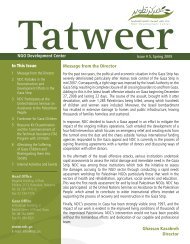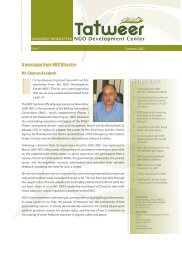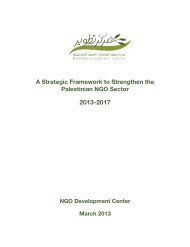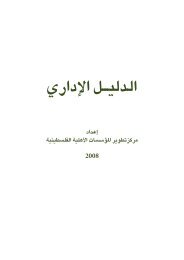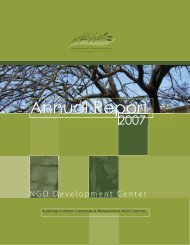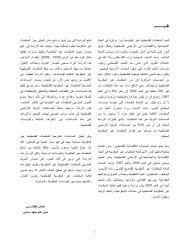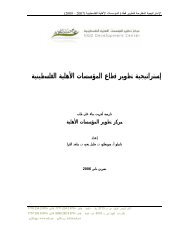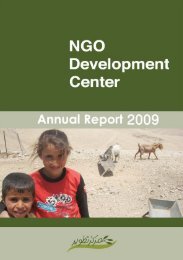Tracking External Donor Funding.pdf - NDC
Tracking External Donor Funding.pdf - NDC
Tracking External Donor Funding.pdf - NDC
You also want an ePaper? Increase the reach of your titles
YUMPU automatically turns print PDFs into web optimized ePapers that Google loves.
Executive Summary<br />
Between 1999 and 2008, external aid to the West Bank<br />
and Gaza Strip increased by over 600% to 3.25 billion<br />
US Dollars per year. During the same time period,<br />
external aid to Palestinian Nongovernmental<br />
Organizations (PNGOs) increased by over 500% from 48<br />
million US Dollars in 1999 to 257 million in 2008.<br />
Throughout this period the level of external aid received<br />
by PNGOs fluctuated, however, it averaged around 10%<br />
over the 10 year period.<br />
According to our findings, not only the amount, but also<br />
the type of external aid entering the WB&GS varied<br />
according to political conditions. During times of<br />
political upheaval, we identified shifts in the destination<br />
of external aid, usually moving away from development<br />
or the Palestinian Authority and towards emergency<br />
relief programs, as well as a shift in the conduits of<br />
external aid, away from bilateral donors and towards<br />
multilateral agencies. According to our findings, PNGOs<br />
are engaged in development activities on a nearly 2:1<br />
basis to Relief, changing only slightly during the<br />
Intifada. Whereas we had expected a higher percentage<br />
of PNGO activities during the Second Intifada, we<br />
learned that much of the external aid to the Occupied<br />
Palestinian Territories during this period was channeled<br />
through International Nongovernmental Organizations<br />
(INGOs) and multilateral agencies engaged in direct<br />
implementation.<br />
Amongst donor groupings, it is clear that Europe, both as<br />
an institution and as individual states, is by far the largest<br />
donor to both the Palestinian Authority and the PNGO<br />
sector, providing nearly 70% of the total funding to the<br />
latter. Aid from the Arab countries to Palestine has<br />
decreased steadily in comparison to Western donors and<br />
primarily contributes to the Palestinian Authority’s<br />
budget. Unlike European and American aid to Palestine<br />
and PNGOs, during times of Political crisis the amount<br />
and impact of Arab aid increases. Aid from the United<br />
States has decreased steadily throughout the period<br />
studied, from around 12% of the total external aid to<br />
PNGOs in 1999 to only 5% in 2008. According to our<br />
findings, nongovernmental donors surpass governmental<br />
sources in external aid to PNGOs, though most of the aid<br />
granted through INGOs comes from national<br />
governments. Prior to the Second Intifada, the opposite<br />
had been true, in which bilateral contributions to the<br />
PNGO sector outmatched those of the INGO sector.<br />
According to our findings, external aid is critical to both<br />
the health of the PA and PNGO sectors. According to<br />
MAS’s estimates, external aid comprises over 60% of the<br />
GNI of the WB&GS. For PNGOs, the dependency is<br />
even more pronounced with around 78% of PNGO<br />
revenues come from external aid. The increase in aid<br />
dependence has occurred along side a decrease in PNGO<br />
funding from the local community in the West Bank and<br />
Gaza Strip.<br />
The primary conclusion of our analysis of externally<br />
funded PNGO activities by sector was the seemingly<br />
clear correlation between political realities and the<br />
sectors receiving external aid. According to our findings<br />
in 2008, PNGOs engaged in Rights-based activities<br />
received the highest proportion of external aid (30%),<br />
followed by PNGOs engaged in the Social Services<br />
sector (26%), Economic Sector (22%), Education (14%)<br />
and Charity and Relief (9%).<br />
According to our survey, external aid to PNGOs engaged<br />
in urban areas increased between 1999 and 2008 from<br />
25% to just under 40%. We also found that PNGOs tend<br />
to focus their efforts in rural areas, spending 40% of their<br />
resources there, despite urban inhabitants making up<br />
only 31% of the Palestinian population. Due to the scale<br />
and importance of UNRWA in providing aid to<br />
Palestinian refugees, PNGOs are less represented in the<br />
refugee target area.<br />
While PNGOs are regionally distributed somewhat close<br />
to the Palestinian population, those who partner with<br />
international agencies are overwhelmingly located in the<br />
Central West Bank, along with the vast majority of<br />
external donors. Though project implementation is more<br />
evenly spread throughout the WB&GS, it is still<br />
disproportionately targeting the Central West Bank in<br />
comparison to the number of people or PNGOs.<br />
x


